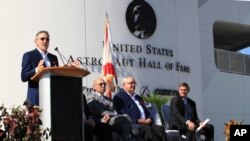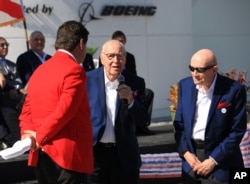NASA’s earliest and greatest astronauts gathered at Kennedy Space Center Friday to mark the grand opening of a new space exhibit in which they’re the stars.
Thirty astronauts, three of them moonwalkers, took part in the outdoor ceremony, including two who had extra reason to celebrate. Fifty years ago Friday, Jim Lovell and Buzz Aldrin launched on Gemini 12, the last of that program.
With all the excitement, Lovell forgot about Friday’s anniversary — until reminded by a reporter. He said spacewalks and rendezvous were refined on the two-man Gemini missions and “opened up the road to Apollo.” He later flew on Apollo — Apollo 8, the first manned flight to the moon, and the infamous, close-call Apollo 13.
‘I can’t believe it’s 50 years’
Lovell’s Boy Scout handbook is on display at the exhibit’s new United States Astronaut Hall of Fame — relocated from its original location six miles down the road — along with his scouting sash and merit badges.
“I can’t believe it’s 50 years” since the last Gemini flight, said Thomas Stafford of Gemini 6 and 9, Apollo 10 and the Apollo-Soyuz joint mission between the United States and Soviet Union.
Stafford’s Gemini 9 capsule is on display. It’s minus its hatches and some other items, he noted, but otherwise still looks in good shape.
“It’s a beautiful exhibit,” Stafford, 86, told The Associated Press. “To me, it’s something that’s inspirational ... motivational for the young people.”
Golden age of NASA
In all, 30 U.S. astronauts spanning Gemini to shuttle — two of them women — gathered at the Kennedy Space Center Visitor Complex for the morning ceremony, which paid high tribute to NASA’s golden age of the 1960s and 1970s.
Also present: the children of the late Alan Shepard, the first American in space, and the late Neil Armstrong, the first man to step onto the moon.
The retired astronauts — 25 of them Hall of Famers in matching navy blazers — joined a few hundred space program workers, military veterans, space buffs and tourists in the sunshine, right outside the new visitor center exhibit, called “Heroes and Legends.” Carved into fiberglass on the side of the building, a 30-foot-tall bas relief of the original Mercury 7 astronauts looked down on the crowd. Mercury 7’s lone survivor, John Glenn, 95, sent best wishes.
The event was deliberately set on Veterans Day. All of the early astronauts were military men, as were many of the later space shuttle fliers. The holiday enabled some children to attend without skipping school; a few dressed up in astronaut suits.
‘Just a lucky guy’
During the ceremony, the 88-year-old Lovell said he doesn’t consider himself in the same company of his own hero, Charles Lindbergh. Ever humble like so many of his colleagues, Lovell said he just did what he thought was “proper and exciting and something for the country.”
“I guess I’m just a lucky guy,” he said, grinning, as some of the audience laughed given his commander’s role on Apollo 13.
Apollo 15 command module pilot Al Worden, 84, pointed out that the visitor complex showcases a Saturn V moon rocket and space shuttle Atlantis, not to mention all these new artifacts and relics “that I think people a thousand years from now are going to be happy to see.”
“They’re going to think back on the wonderful days that we’ve had here,” Worden told the crowd. “And I guess in that same vein, that makes me a relic, too.”
Apollo 16 moonwalker Charlie Duke, 81, offered this advice to everyone, particularly the young people in the audience and watching on NASA TV: “Dream big, aim high.”









